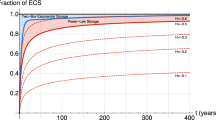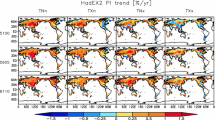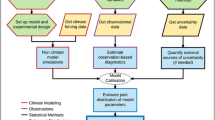Abstract
Equilibrium climate sensitivity (ECS) is inferred from estimates of instrumental-period warming attributable solely to greenhouse gases (AW), as derived in two recent multi-model detection and attribution (D&A) studies that apply optimal fingerprint methods with high spatial resolution to 3D global climate model simulations. This approach minimises the key uncertainty regarding aerosol forcing without relying on low-dimensional models. The “observed” AW distributions from the D&A studies together with an observationally-based estimate of effective planetary heat capacity (EHC) are applied as observational constraints in (AW, EHC) space. By varying two key parameters—ECS and effective ocean diffusivity—in an energy balance model forced solely by greenhouse gases, an invertible map from the bivariate model parameter space to (AW, EHC) space is generated. Inversion of the constrained (AW, EHC) space through a transformation of variables allows unique recovery of the observationally-constrained joint distribution for the two model parameters, from which the marginal distribution of ECS can readily be derived. The method is extended to provide estimated distributions for transient climate response (TCR). The AW distributions from the two D&A studies produce almost identical results. Combining the two sets of results provides best estimates (5–95 % ranges) of 1.66 (0.7–3.2) K for ECS and 1.37 (0.65–2.2) K for TCR, in line with those from several recent studies based on observed warming from all causes but with tighter uncertainty ranges than for some of those studies. Almost identical results are obtained from application of an alternative profile likelihood statistical methodology.


Similar content being viewed by others
References
Aldrin M, Holden M, Guttorp P, Skeie RB, Myhre G, Berntsen TK (2012) Bayesian estimation of climate sensitivity based on a simple climate model fitted to observations of hemispheric temperatures and global ocean heat content. Environmetrics 23:253–271
Allen MR, Tett SFB (1999) Checking for model consistency in optimal fingerprinting. Clim Dyn 15:419–434
Allen MR, Frame DJ, Huntingford C, Jones CD, Lowe JA, Meinshausen M, Meinshausen N (2009) Warming caused by cumulative carbon emissions towards the trillionth tonne. Nature 458:1163–1166
Andrews DG, Allen MR (2008) Diagnosis of climate models in terms of transient climate response and feedback response time. Atmos Sci Lett 9:7–12
Andrews T, Gregory JM, Webb MJ (2014) The dependence of radiative forcing and feedback on evolving patterns of surface temperature change in climate models. J Clim 28:1630–1648
Armour KC, Bitz CM, Roe GR (2013) Time-varying climate sensitivity from regional feedbacks. J Clim 26:4518–4534
Bindoff NL, Stott PA et al (2014) Detection and attribution of climate change: from global to regional. Climate change 2013: the physical science basis contribution of working group I to the fifth assessment report of the Intergovernmental Panel on Climate Change. Cambridge University Press
Collins M, Knutti R et al (2014) Long-term climate change: projections, commitments and irreversibility. Climate change 2013: the physical science basis contribution of working group I to the fifth assessment report of the Intergovernmental Panel on Climate Change. Cambridge University Press
Enfield DB, Mestas-Nunez AM, Trimble PJ (2001) The Atlantic Multidecadal Oscillation and its relationship to rainfall and river flows in the continental US. Geophys Res Lett 28:2077–2080
Forster PM de F, Taylor KE (2006) Climate forcings and climate sensitivities diagnosed from coupled climate model integrations. J Clim 19:6181–6194
Frame DJ, Booth BBB, Kettleborough JA, Stainforth DA, Gregory JM, Collins M, Allen MR (2005) Constraining climate forecasts: the role of prior assumptions. Geophys Res Lett 32:L09702. doi:10.1029/2004GL022241
Frame DJ, Stone DA, Stott PA, Allen MR (2006) Alternatives to stabilization scenarios. Geophys Res Lett 33:L14707. doi:10.1029/2006GL025801
Gillett NP, Wehner MF, Tett SFB, Weaver AJ (2004) Testing the linearity of the response to combined greenhouse gas and sulfate aerosol forcing. Geophys Res Lett 31, 14, L14201:1–4. doi:10.1029/2004GL020111
Gillett NP, Arora VK, Flato GM, Scinocca JF, von Salzen K (2012) Improved constraints on 21st-century warming derived using 160 years of temperature observations. Geophys Res Lett 39:L01704. doi:10.1029/2011GL050226
Gillett NP, Arora VK, Matthews D, Stott PA, Allen MR (2013) Constraining the ratio of global warming to cumulative CO2 emissions using CMIP5 simulations. J Clim. doi:10.1175/JCLI-D-12-00476.1
Gordon C, Cooper C, Senior CA, Banks H, Gregory JM, Johns TC, Mitchell JFB, Wood RA (2000) The simulation of SST, sea ice extents and ocean heat transports in a version of the Hadley Centre coupled model without flux adjustments. Clim Dyn 16:147–168
Gregory JM, Forster PM (2008) Transient climate response estimated from radiative forcing and observed temperature change. J Geophys Res 113:D23105. doi:10.1029/2008/JD010405
Harris GR, Sexton DMH, Booth BBB, Collins M, Murphy JM (2013) Probabilistic projections of transient climate change. Clim Dyn 40:2937–2972. doi:10.1007/s00382-012-1647-y
Hasselmann K (1997) Multi-pattern fingerprint method for detection and attribution of climate change. Clim Dyn 13:601–611
Hegerl G, Zwiers F (2011) Use of models in detection and attribution of climate change. WIREs Clim Change 2:570–591
Hegerl GC, von Storch S, Hasselmann K, Santer BD, Cubasch U, Jones PD (1996) Detecting greenhouse gas induced climate change with an optimal fingerprint method. J Clim 9:2281–2306
Huang Y, Zhang M (2014) The implication of radiative forcing and feedback for meridional energy transport. Geophys Res Lett 41:1665–1672
Imbers J, Lopez A, Huntingford C, Allen M (2014) Sensitivity of climate change detection and attribution to the characterization of internal climate variability. J Clim 27:3477–3491
Jones GS, Stott PA, Christidis N (2013) Attribution of observed historical near surface temperature variations to anthropogenic and natural causes using CMIP5 simulations. J Geophys Res Atmos. doi:10.1002/jgrd.50239
Levitus S et al (2012) World ocean heat content and thermosteric sea level change (0–2000 m) 1955–2010. Geophys Res Lett 39:L10603
Lewis N (2013) An objective Bayesian improved approach for applying optimal fingerprint techniques to estimate climate sensitivity. J Clim 26:7414–7429
Lewis N (2014) Objective inference for climate parameters: Bayesian, transformation-of-variables, and profile likelihood approaches. J Clim 27:7270–7284
Lewis N, Curry JA (2014) The implications for climate sensitivity of AR5 forcing and heat uptake estimates. Clim. Dyn. DOI 10.1007/s00382-014-2342-y
Libardoni AG, Forest CE (2011) Sensitivity of distributions of climate system properties to the surface temperature dataset. Geophys Res Lett 38:L22705. doi:10.1029/2011GL049431
Lyman JM, Johnson GC (2014) Estimating global ocean heat content changes in the upper 1800 m since 1950 and the influence of climatology choice. J Clim 27:1945–1957
Mardia KV, Kent JT, Bibby JM (1979) Multivariate analysis. Academic Press, London
Masters T (2014) Observational estimate of climate sensitivity from changes in the rate of ocean heat uptake and comparison to CMIP5 models. Clim Dyn 42:2173–2181. doi:10.1007/s00382-013-1770-4
Morice CP, Kennedy JJ, Rayner NA, Jones PD (2012) Quantifying uncertainties in global and regional temperature change using an ensemble of observational estimates: the HadCRUT4 data set. J Geophys Res 117:D08101. doi:10.1029/2011JD017187
Myhre G, Shindell D et al (2014) Anthropogenic and natural radiative forcing. Climate change 2013: the physical science basis contribution of working group I to the fifth assessment report of the Intergovernmental Panel on Climate Change. Cambridge University Press
Otto A, Otto FEL, Boucher O, Church J, Hegerl G, Forster PM, Gillett NP, Gregory J, Johnson GC, Knutti R, Lewis N, Lohmann U, Marotzke J, Myhre G, Shindell D, Stevens B, Allen MR (2013) Energy budget constraints on climate response. Nat Geosci 6:415–416
Pawitan Y (2001) In all likelihood: statistical modeling and inference using likelihood, Chap 3.4. Oxford University Press, Oxford
Prather M, Flato G, Friedlingstein P, Jones C, Lamarque J-F, Liao H, Rasch P (eds) (2014) Annex II: climate system scenario tables. Climate change 2013: the physical science basis contribution of working group I to the fifth assessment report of the Intergovernmental Panel on Climate Change. Cambridge University Press
Rhein M, Rintoul SR et al (2014) Observations: ocean. Climate change 2013: the physical science basis contribution of working group I to the fifth assessment report of the Intergovernmental Panel on Climate Change. Cambridge University Press
Ribes A, Terray L (2013) Application of regularised optimal fingerprinting to attribution. Part II: application to global near-surface temperature. Clim Dyn 41:2837–2853. doi:10.1007/s00382-013-1736-6
Ring MJ, Lindner D, Cross EF, Schlesinger ME (2012) Causes of the global warming observed since the 19th century. Atmos Clim Sci 2:401–415
Rose BEJ, Armour KC, Battisti DS, Feldl N, Koll DDB (2014) The dependence of transient climate sensitivity and radiative feedbacks on the spatial pattern of ocean heat uptake. Geophys Res Lett 41:1071–1078
Schwartz SE (2012) Determination of Earth’s transient and equilibrium climate sensitivities from observations over the twentieth century: strong dependence on assumed forcing. Surv Geophys 33(3-4):745–777
Shindell DT (2014) Inhomogeneous forcing and transient climate sensitivity. Nat Clim Change. doi:10.1038/NCLIMATE2136
Skeie RB, Berntsen T, Aldrin M, Holden M, Myhre G (2014) A lower and more constrained estimate of climate sensitivity using updated observations and detailed radiative forcing time series. Earth Syst Dyn 5:139–175
Sokolov AP, Forest CE, Stone PH (2003) Comparing oceanic heat uptake in AOGCM transient climate change experiments. J Clim 16:1573–1582
Taylor KE, Stouffer RJ, Meehl GA (2012) An overview of CMIP5 and the experiment design. Bull Am Meteorol Soc 93:485–498
Zelinka MD, Hartmann DL (2012) Climate feedbacks and their implications for poleward energy flux changes in a warming climate. J Clim 25:608–624
Acknowledgments
I thank Gregory Johnson for supplying the data underlying Box 3.1, Fig. 1 of AR5, Gareth Jones for supplying numerical results and other information relating to Jones et al. (2013), and Judith Curry, Jonathan Jones and Paul Kirwan and two reviewers for helpful comments that significantly improved the manuscript.
Author information
Authors and Affiliations
Corresponding author
Electronic supplementary material
Below is the link to the electronic supplementary material.
Appendix: Further details of method used to estimate ECS
Appendix: Further details of method used to estimate ECS
As stated in Sect. 2, the method closely follows that in Lewis (2014). One observable used, T A, represents the estimated GMST change over the full analysis period attributable to greenhouse gases, based on the linear trend in GMST from the simulated response to GHG-only forcing. In the case of the observationally-constrained estimate of T A, derived from GCM simulations, the simulated linear trend has been scaled by the GHG regression coefficient estimated in the attribution analysis. The EBM-simulation trend estimate of T A is unscaled. The other observable, effective heat capacity C H, is taken to be the same for GHG-only forcing as it is for historical warming (Frame et al. 2006). Model accuracy is assumed, with there being a ‘true’ setting \((S^{\text{t}} ,K_{\text{v}}^{\text{t}} )\) of model parameters that simulates ‘true’ (error-free) values \((T_{\text{A}}^{\text{t}} ,C_{\text{H}}^{\text{t}} )\). Estimated (posterior) probability density functions (PDFs) for the true values of the observables (those that would have been observed in the absence of error and internal variability), \(p_{{T_{\text{A}}^{\text{t}} }} (T_{\text{A}}^{{}} )\) and \(p_{{C_{\text{H}}^{\text{t}} }} (C_{\text{H}}^{{}} )\), are derived respectively from the uncertainty ranges given in the relevant attribution analysis and from observational data error distributions, as described in Sect. 2. Since C H is a measure of heat capacity, it should be independent of the change in GMST and hence of T A. The joint density for T A and C H, \(p_{{T_{\text{A}}^{\text{t}} ,C_{\text{H}}^{\text{t}} }} (T_{\text{A}}^{{}} ,C_{\text{H}}^{{}} )\), is accordingly obtained by multiplying their individual densities. As the EBM is a deterministic rather than a statistical model, the dispersion of the estimated PDFs for S must entirely reflect uncertainties in the observationally-constrained estimates of T A and C H.
The EBM used has a diffusive ocean below a 75-m-deep mixed layer (Andrews and Allen 2008, Eq. 8). EBM simulations are run using all parameter value combinations lying on a grid that is uniformly spaced in terms of S and K v and sufficiently large for there to be negligible probability of the true values of S or K v lying outside it. Four hundred values of S from 0.05 to 20 K, and sixty values of K v from 0 to 2.95 cm s−0.5, were used. For notational convenience, here K v represents the square root of effective ocean vertical diffusivity, which controls C H in an approximately linear manner (Sokolov et al. 2003). The annual EBM-simulation time series are used to compute \(T_{\text{A}}^{m}\) and \(C_{\text{H}}^{m}\). \(T_{\text{A}}^{m}\) is calculated as the linear-regression-based change in modelled global surface temperature over the period used in the relevant attribution analysis (that is, the product of the regression trend per annum and the length of the period in years). \(C_{\text{H}}^{m}\) is calculated as the ratio of changes in modelled ocean heat content and global temperature between the means of 11-year periods centred on 1963 and 2006, thus using data spanning 1958–2011, the period covered by the observational data used.
The observables and parameters are both bivariate and, with the EBM being deterministic, the model \(T_{\text{A}}^{m}\) and \(C_{\text{H}}^{m}\) values are smooth differentiable functions of the parameters. Moreover, each pair of (\(T_{\text{A}}^{m}\), \(C_{\text{H}}^{m}\)) values corresponds to a unique pair of \((S^{\text{m}} ,K_{\text{v}}^{\text{m}} )\) values and vice versa. Accordingly, there is an invertible both-ways differentiable one-to-one relationship between joint model parameter settings, \((S^{\text{m}} ,K_{\text{v}}^{\text{m}} )\), and joint values of (\(T_{\text{A}}^{m}\), \(C_{\text{H}}^{m}\)). Given the assumption of model accuracy the same relationship exists between the true joint values \((T_{\text{A}}^{\text{t}} ,C_{\text{H}}^{\text{t}} )\) and \((S^{\text{t}} ,K_{\text{v}}^{\text{t}} )\). The estimated joint posterior PDF for \((S^{\text{t}} ,K_{\text{v}}^{\text{t}} )\) is therefore directly and uniquely related to that for \((T_{\text{A}}^{\text{t}} ,C_{\text{H}}^{\text{t}} )\) through the standard formula (Mardia et al. 1979) for converting PDFs upon a transformation of variables:
where f is the functional relationship between \((S^{\text{m}} ,K_{\text{v}}^{\text{m}} )\) and \((T_{\text{A}}^{\text{m}} ,C_{\text{H}}^{\text{m}} )\) and \(J_{f}\) is the absolute Jacobian determinant, given by:
The EBM simulations provide the values of \((T_{\text{A}}^{\text{m}} ,C_{\text{H}}^{\text{m}} )\) at each \((S^{\text{t}} ,K_{\text{v}}^{\text{t}} )\) combination, and hence the form of f and, by numerical differentiation, of \(J_{f}\). Once the joint posterior PDF for \((S^{\text{t}} ,K_{\text{v}}^{\text{t}} )\) has been calculated, a marginal PDF for \(S^{\text{t}}\) is obtained by integrating out K v, following standard Bayesian methodology. Uncertainty ranges reflect the percentile points of the corresponding cumulative probability distribution function (CDF), and are termed credible intervals.
The frequentist validity, in terms of repeated sampling properties, of the credible intervals provided by the main objective Bayesian method is checked by also deriving confidence intervals for S using a profile-likelihood approach (Allen et al. 2009). Profile likelihood is an alternative objective parameter inference method giving confidence intervals with at least approximate frequentist validity (Pawitan 2001). Profile likelihoods for AW and EHC are derived, and multiplicatively combined to form a joint (AW, EHC) likelihood. That joint likelihood is then restated in \((S,K_{v} )\) coordinates (likelihoods, unlike PDFs, being unaffected by a change in variables), and the profile likelihood for S computed. Confidence intervals are then calculated using the signed root log-likelihood ratio (SRLR) method.
Rights and permissions
About this article
Cite this article
Lewis, N. Implications of recent multimodel attribution studies for climate sensitivity. Clim Dyn 46, 1387–1396 (2016). https://doi.org/10.1007/s00382-015-2653-7
Received:
Accepted:
Published:
Issue Date:
DOI: https://doi.org/10.1007/s00382-015-2653-7




